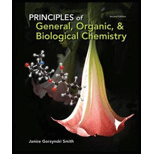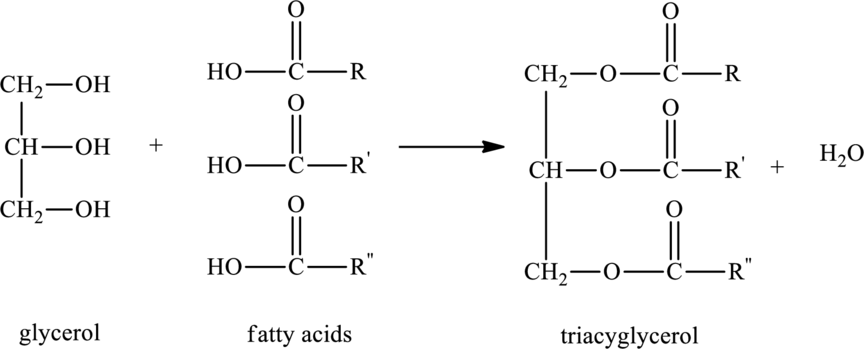
Principles of General Organic & Biological Chemistry
2nd Edition
ISBN: 9780077633721
Author: Janice Smith
Publisher: Mcgraw-hill Higher Education (us)
expand_more
expand_more
format_list_bulleted
Concept explainers
Question
Chapter 15.4, Problem 15.9P
Interpretation Introduction
Interpretation:
Structure of cocoa butter has to be drawn.
Concept Introduction:
Triacylglycerols are lipids that are formed by two or more similar or different fatty acids. They are also called triglycerides and are hydrophobic and nonpolar in nature. Addition of glycerol and three similar or different fatty acids results into triesters that is also triacylglycerols. The general reaction for the synthesis of triacylglycerol is as follows:

Expert Solution & Answer
Want to see the full answer?
Check out a sample textbook solution
Students have asked these similar questions
Concentration (mg/l)
Peak Area
0
158
10
10241
20
18425
30
26457
40
37125
50
44256
60
56124
Question: Determine the regression equation (a and b coefficients) from first principles
Concentration (mg/l)
Peak Area
0
158
10
10241
20
18425
30
26457
40
37125
50
44256
60
56124
You have been asked to determine the concentration of citral in a highly valued magnolia essential oil.
QUESTION: Calculate the concentration of citral in your highly valued magnolia essential oil which returns a peak area of 41658
Need help with these problems...if you can please help me understand problems E & F.
Chapter 15 Solutions
Principles of General Organic & Biological Chemistry
Ch. 15.1 - In which solvents or solutions will a lipid be...Ch. 15.2 - (a) Draw a skeletal structure for each fatty acid....Ch. 15.2 - Prob. 15.3PCh. 15.2 - Prob. 15.4PCh. 15.3 - Draw the structure of a wax formed from stearic...Ch. 15.3 - One component of jojoba oil is a wax formed from...Ch. 15.3 - What hydrolysis products are formed when cetyl...Ch. 15.4 - Draw the structure of a triacylglycerol that...Ch. 15.4 - Prob. 15.9PCh. 15.4 - Draw the structure of a triacylglycerol that fits...
Ch. 15.5 - Draw the products formed from hydrolysis of each...Ch. 15.5 - Prob. 15.12PCh. 15.6 - Draw the structure of two different cephalins...Ch. 15.6 - Classify each lipid as a triacylglycerol,...Ch. 15.7 - Why are phospholipids rather than triacylglycerols...Ch. 15.7 - Prob. 15.16PCh. 15.8 - Prob. 15.17PCh. 15.8 - Prob. 15.18PCh. 15.9 - Prob. 15.19PCh. 15.9 - Prob. 15.20PCh. 15.10 - Why is it much easier to overdose on a fat-soluble...Ch. 15.10 - Prob. 15.22PCh. 15 - Prob. 15.23UKCCh. 15 - Prob. 15.24UKCCh. 15 - Prob. 15.25UKCCh. 15 - What hydrolysis products are formed when the wax...Ch. 15 - Prob. 15.27UKCCh. 15 - Prob. 15.28UKCCh. 15 - Draw the products formed when the given...Ch. 15 - Prob. 15.30UKCCh. 15 - Prob. 15.31UKCCh. 15 - Prob. 15.32UKCCh. 15 - Prob. 15.33APCh. 15 - Label each compound as a hydrolyzable or...Ch. 15 - Prob. 15.35APCh. 15 - Prob. 15.36APCh. 15 - Prob. 15.37APCh. 15 - How does each of the following affect the melting...Ch. 15 - Rank the fatty acids in order of increasing...Ch. 15 - How would you expect the melting points of the...Ch. 15 - Prob. 15.41APCh. 15 - Why are soaps water soluble, but the fatty acids...Ch. 15 - Draw the structure of a wax formed from palmitic...Ch. 15 - Prob. 15.44APCh. 15 - Prob. 15.45APCh. 15 - Prob. 15.46APCh. 15 - Prob. 15.47APCh. 15 - What hydrolysis products are formed when each wax...Ch. 15 - Draw a triacylglycerol that fits each description:...Ch. 15 - Draw a triacylglycerol that fits each description:...Ch. 15 - Prob. 15.51APCh. 15 - Prob. 15.52APCh. 15 - Prob. 15.53APCh. 15 - Prob. 15.54APCh. 15 - Prob. 15.55APCh. 15 - Draw the products formed when the given...Ch. 15 - Prob. 15.57APCh. 15 - Prob. 15.58APCh. 15 - Prob. 15.59APCh. 15 - Prob. 15.60APCh. 15 - Prob. 15.61APCh. 15 - Why are LDLs soluble in the blood?Ch. 15 - Describe the role of HDLs and LDLs in cholesterol...Ch. 15 - Prob. 15.64APCh. 15 - Prob. 15.65APCh. 15 - Prob. 15.66APCh. 15 - Answer each question with regards to vitamins A...Ch. 15 - Answer each question in Problem 15.67 for vitamins...Ch. 15 - Prob. 15.69APCh. 15 - Prob. 15.70APCh. 15 - Prob. 15.71APCh. 15 - How are soaps and phosphoacylglycerols similar in...Ch. 15 - Some fish oils contain triacylglycerols formed...Ch. 15 - Some marine plankton contain triacylglycerols...Ch. 15 - Prob. 15.75APCh. 15 - Prob. 15.76APCh. 15 - Prob. 15.77APCh. 15 - Prob. 15.78APCh. 15 - Prob. 15.79CPCh. 15 - Prob. 15.80CP
Knowledge Booster
Learn more about
Need a deep-dive on the concept behind this application? Look no further. Learn more about this topic, chemistry and related others by exploring similar questions and additional content below.Similar questions
- Please help me solve these problems. Thank you in advance.arrow_forwardPredict the products of this organic reaction: O N IN A N + H2O + HCI ? Specifically, in the drawing area below draw the skeletal ("line") structure of the product, or products, of this reaction. If there's more than one product, draw them in any arrangement you like, so long as they aren't touching. If there aren't any products because this reaction won't happen, check the No reaction box under the drawing area. 田 C + Explanation Check Click and drag to start drawing a structure. C © 2025 McGraw Hill LLC. All Rights Reserved. Terms of Use | Privacy Centerarrow_forward6. For each of the following, fill in the synthesis arrows with reagents and show the intermediates. You DO NOT need to use the same number of arrows that are shown (you may use more or less), but the product must be formed from the reactant. Then write the mechanism of one step in the synthesis (you can choose which step to write the mechanism for), including all reagents required, clearly labeling the nucleophile and electrophile for each step, and using curved arrows to show the steps in the mechanism. a. b. OHarrow_forward
- Draw the productsarrow_forwardDraw the correct productsarrow_forwardE Organic Chemistry Maxwell Draw the correct products, in either order, for the ozonolysis reaction: 1) O3, CH2Cl2, -78 °C Product 1 + Product 2 2) Zn, HOAc Draw product 1. Select Draw Templates More C H O presented by M Draw product 2. Erase Select Draw Templates M / # # carrow_forward
- ✓ edict the products of this organic reaction: ---- ။ A CH3–C−NH–CH2–C−CH3 + KOH ? Specifically, in the drawing area below draw the condensed structure of the product, or products, of this reaction. If there's more than one product, draw them in any arrangement you like, so long as they aren't touching. If there aren't any products because this reaction won't happen, check the No reaction box under the drawing area. Explanation Check Click anywhere to draw the first atom of your structure. C 2025 McGraw Hill LLC. All Rights Reserved. Terms of Use | Privacy Center | Accessibiliarrow_forwardPredict the product of this organic reaction: A HO-C-CH3 + CH3NH2 P+ H2O Specifically, in the drawing area below draw the condensed structure of P. If there is no reasonable possibility for P, check the No answer box under the drawing area. Explanation Check Click anywhere to draw the first atom of your structure. marrow_forwardH 1) OsO4, pyridine 2) Na2SO3 or NaHSO3 in H₂O 2 productsarrow_forward
- ● Biological Macromolecules Naming and drawing cyclic monosaccharides Your answer is incorrect. • Row 1: Your answer is incorrect. Row 3: Your answer is incorrect. • Row 4: Your answer is incorrect. Try again... 0/5 Give the complete common name, including anomer and stereochemistry labels, of the following molecules. You will find helpful information in the ALEKS resource. CH2OH OH OH H H I H OH OH H] H CH2OH H OH ẞ-L-sorbose HOCH2 OH OH H HOCH2 H OH OH H OH H H CH2OH OH H H OH H I- H OH H OH Explanation Recheck W E R % 25 α B Y X & 5 D F G H McGraw Hill LLC. All Rights Reserved. Terms of Use | Pr Parrow_forwardWhat is the missing reactant in this organic reaction? + R -A HO IN + H₂O Specifically, in the drawing area below draw the skeletal ("line") structure of R. If there is more than one reasonable answer, you can draw any one of them. If there is no reasonable answer, check the No answer box under the drawing area. Note for advanced students: you may assume no products other than those shown above are formed. Explanation Check Click and drag to start drawing a structure. © 2025 McGraw Hill LLC. All Rights Reserved. Terms of Use | Privacy Centerarrow_forwardStuc X ctclix ALE X A ALE אן A ALEX Lab (195 X Nut x M Inb x NU X NUT X Unt x + → C www-awu.aleks.com/alekscgi/x/Isl.exe/10_u-lgNslkr7j8P3jH-IQ1g8NUi-mObKa_ZLx2twjEhK7mVG6PulJI006NcKTV37JxMpZuyrVCdQolLAKqp_7U3r1GUD3... New Chrome available: Naomi Question 26 of 39 (4 points) | Question Attempt: 1 of Unlimited Give the IUPAC name. 2,3-dimethylhexane Part: 1/2 Part 2 of 2 Draw the skeletal structure of a constitutional isomer of the alkane above that contains a different number of carbons in its longest chain. Skip Part Check Click and drag to start drawing a structure. 3 Finance headline Q Search mwa Harvard Intensifi... X Save For Later 00 dlo HB Submit Assignment 2025 McGraw Hill LLC. All Rights Reserved. Terms of Use | Privacy Center | Accessibility a 9:11 PM 4/22/2025arrow_forward
arrow_back_ios
SEE MORE QUESTIONS
arrow_forward_ios
Recommended textbooks for you
 Chemistry for Today: General, Organic, and Bioche...ChemistryISBN:9781305960060Author:Spencer L. Seager, Michael R. Slabaugh, Maren S. HansenPublisher:Cengage Learning
Chemistry for Today: General, Organic, and Bioche...ChemistryISBN:9781305960060Author:Spencer L. Seager, Michael R. Slabaugh, Maren S. HansenPublisher:Cengage Learning General, Organic, and Biological ChemistryChemistryISBN:9781285853918Author:H. Stephen StokerPublisher:Cengage Learning
General, Organic, and Biological ChemistryChemistryISBN:9781285853918Author:H. Stephen StokerPublisher:Cengage Learning Organic And Biological ChemistryChemistryISBN:9781305081079Author:STOKER, H. Stephen (howard Stephen)Publisher:Cengage Learning,
Organic And Biological ChemistryChemistryISBN:9781305081079Author:STOKER, H. Stephen (howard Stephen)Publisher:Cengage Learning, Introduction to General, Organic and BiochemistryChemistryISBN:9781285869759Author:Frederick A. Bettelheim, William H. Brown, Mary K. Campbell, Shawn O. Farrell, Omar TorresPublisher:Cengage Learning
Introduction to General, Organic and BiochemistryChemistryISBN:9781285869759Author:Frederick A. Bettelheim, William H. Brown, Mary K. Campbell, Shawn O. Farrell, Omar TorresPublisher:Cengage Learning

Chemistry for Today: General, Organic, and Bioche...
Chemistry
ISBN:9781305960060
Author:Spencer L. Seager, Michael R. Slabaugh, Maren S. Hansen
Publisher:Cengage Learning

General, Organic, and Biological Chemistry
Chemistry
ISBN:9781285853918
Author:H. Stephen Stoker
Publisher:Cengage Learning

Organic And Biological Chemistry
Chemistry
ISBN:9781305081079
Author:STOKER, H. Stephen (howard Stephen)
Publisher:Cengage Learning,

Introduction to General, Organic and Biochemistry
Chemistry
ISBN:9781285869759
Author:Frederick A. Bettelheim, William H. Brown, Mary K. Campbell, Shawn O. Farrell, Omar Torres
Publisher:Cengage Learning